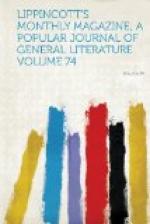And this evil fame still clings to Munich, in spite of all that has been done to improve its condition, and of all that has been written to purge it of its contempt. Efforts of the latter kind have indeed been prodigious, increasing with the growing importance of the place as a centre of education in science and art. Local medical authorities issue from time to time ingenious pamphlets on hygienic investigations, with particular application to the suspicion under which their city labors in this regard; the newspapers keep up the whitewashing process with diligence, not forgetting to hold up frequently before their readers the sanitary shortcomings of Vienna and Berlin; nay, the traveler is met at the very threshold of his hotel by a tiny tract containing not only a list of the principal sights, but also a comforting assurance that the climate is not so bad as has been represented, and that by wearing sufficient wrappings and avoiding the ordinary drinking water, strangers may hope to accomplish their visit and escape unharmed. Surely no other city takes such benevolent pains to reassure its inhabitants and instruct and warn its stranger-guests: perhaps it is because deeds have not kept pace with words that assertion and argument have hitherto failed of the desired effect. The protracted, repeated cholera epidemic of 1873-74 may well challenge a close observation of the situation, surroundings and sanitary condition of Munich as a means of ascertaining the causes of this exceptional visitation, as well as of the continual existence of an indigenous disease which, more than almost any other, is dependent upon circumstances within the power of man to control.
Instead, therefore, of constructing the cholera and the typhus out of our “inner consciousness,” as certain of the physicians and hygienists of Munich, in true German fashion, appear disposed to do, let us look at some of the facts of the case—facts sufficiently obvious to be perceptible to any person of intelligence, and the nature of which is so well understood as to be accepted at once as bearing closely upon the subject in question.




